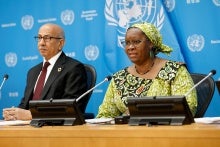[Check against delivery]
Dear members of the media, ladies and gentlemen. Thank you for joining us to launch the 2024 Gender Equality Snapshot. This report is not just about aggregation of the data; it also allows us to connect, discuss and advance solutions.
As Mr. Hanif has highlighted, gender equality, the empowerment of women and girls, and the protection of their rights, fuels the progress of the Sustainable Development Goals. Without it, the Sustainable Development Agenda will remain a distant dream.
And women and girls cannot wait to live in an equal world, with equal rights, equal voice, and equal opportunities.
The report offers some cause for celebration. Women’s poverty is declining. Girls have made important strides in education. We see a push for positive legal reforms that promote women’s rights, with huge benefits. For example, countries that have enacted domestic violence legislation have lower rates of intimate partner violence than those without such legislation (9.5 per cent compared to 16.1 per cent).
However, as we present this important report, the reality is also that progress is far too slow, and we remain off track. Inequalities are increasing, women and girls are living in poverty, and their lives are being wrecked by violence in all countries of the world. They can’t wait for this discrimination and violence to end.
We’re racing against time: not a single SDG 5 indicator has been achieved, and only 2 out of 18 indicators are close. Without acceleration, a girl born today will be 39 years old before women hold as many seats in parliament as men; 68 years old before child marriage ends; and an extraordinary 137 years old before extreme poverty for women and girls is eradicated. Last year 612 million women and girls lived within 50 kilometres of an armed conflict, with a shocking 50 per cent increase in conflict-related sexual violence crimes mainly perpetrated against them.
A future without gender equality, where women’s and girls’ full potential is not unleashed, is a world of missed opportunities. The annual global cost of the education skills deficit is over $10 trillion, more than the GDP of France and Japan combined. Low- and middle-income countries will lose $500 billion in economic activity in the next five years if they don’t address the gender digital divide.
The solutions are clear—invest in women and girls, and the world will thrive, communities will be resilient, and households will prosper. Implementing a package of policies that includes social protection could reduce extreme poverty for 115 million women by 2050. Closing gender gaps in farm productivity and food system wages could raise women farmers’ incomes and increase global GDP by nearly $1 trillion. Investing in the care sector and in infrastructure could create 300 million new decent low-carbon jobs. Having more women in decision-making is the way to move the needle on SDG 5. In one of the biggest electoral years in recent history, 107 countries have never had a woman Head of State. This is our opportunity for change.
As world leaders gather for the Summit of the Future next week, they must feel the pressure to take actions that can close gender gaps. While distant, it is still an achievable objective.
The 30th anniversary of the Beijing Declaration and Platform for Action, in 2025, brings us a unique opportunity to accelerate progress and take bold actions around women’s leadership, green economies, ending violence against women, peace and security, and closing the gender digital divide, among others.
The Beijing Declaration and Platform for Action, adopted in 1995 during the Fourth World Conference on Women, remains the most visionary blueprint for gender equality, the empowerment and rights of women and girls.
As we move forward, let us remember that gender equality is not just a goal but a fundamental human right. Together, we have the power to accelerate progress and create transformative change. We urge world leaders to act now—use today’s report to drive bold, evidence-based policies that deliver real, lasting change for women and girls.
Thank you.

